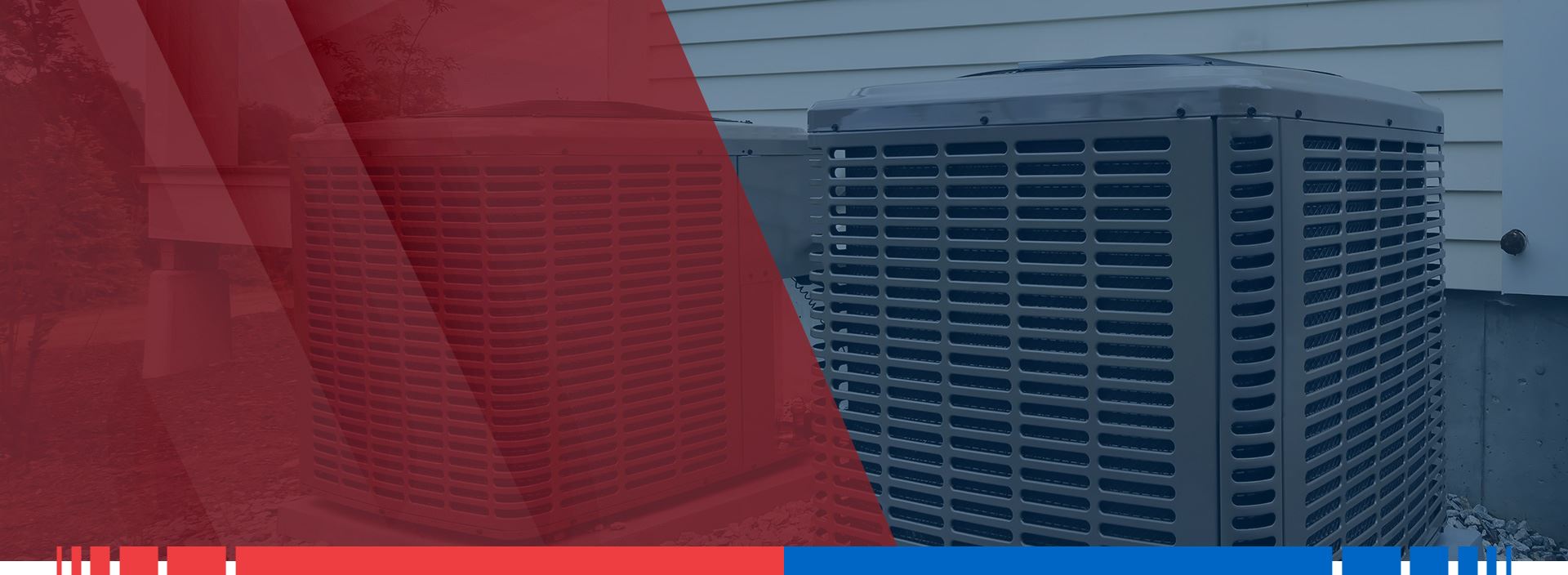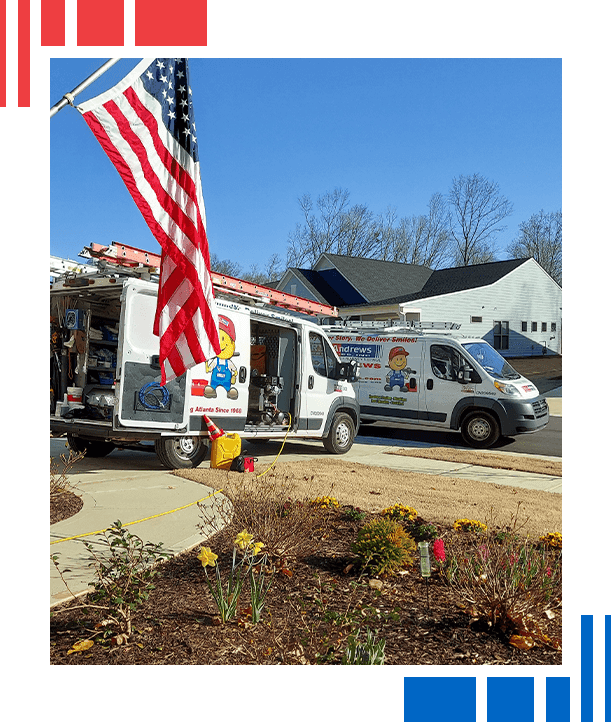
Serving homeowners and businesses throughout the Greater Atlanta area, Savannah, and the Hilton Head area of South Carolina for over 55 years.

HVAC Services in Atlanta, GA
Providing HVAC Installation, Repair & Maintenance Throughout the Metro Atlanta Area
Atlanta is no stranger to a slew of weather throughout the year. Because of this, it’s crucial that homeowners have a reliable HVAC system ready to kick on to meet whatever their needs may be, from heating in the winter to AC in the summer. For a whole range of services, a team of HVAC professionals is needed to supply top-notch installations, repairs, and more, and the team at R.S. Andrews has you covered for whatever service you’re in the market for!
When it comes to maintaining a comfortable home or business in Atlanta, reliable HVAC services are essential. At RS Andrews, we specialize in providing top-quality heating, ventilation, and air conditioning solutions for both residential and commercial properties. Whether you need a new installation, repair, maintenance, or system replacement, our experienced technicians are here to ensure your HVAC system operates efficiently year-round.
With years of service to the Atlanta community, RS Andrews has built a reputation for excellence, professionalism, and customer satisfaction. We understand the unique demands of the Atlanta climate and offer HVAC solutions tailored to your specific needs, ensuring comfort and energy efficiency in every season.
When you’re ready to schedule an HVAC service with us in Atlanta, Savannah or Alpharetta, call (470) 264-8128 or reach out online!
24-Hour Emergency HVAC Services in Atlanta Area
If your heater or AC unit fails you in the middle of extreme weather, it can not only create an overall unpleasant atmosphere but can also pose risks to your wellbeing. In order to stay safe and comfortable on a blistering summer day or freezing winter night, R.S. Andrews offers emergency HVAC services for when such issues just can’t wait!
Your Trusted HVAC Contractor in Atlanta, GA
Living in Atlanta means experiencing a diverse range of weather conditions, from sweltering summers to chilly winters. As a local HVAC contractor, we understand the challenges that homeowners face when their heating or cooling systems falter. The City of Atlanta and surrounding areas, including Alpharetta and Savannah, often see extreme temperatures that can put a strain on your HVAC system.
Local government resources, such as the Atlanta Department of Watershed Management, emphasize the importance of energy efficiency in homes. By choosing our HVAC services, you not only ensure a comfortable living environment but also contribute to energy conservation efforts in our community.
We know that HVAC emergencies can happen at the most inconvenient times, often during peak weather conditions. Whether you're dealing with a malfunctioning air conditioner on a hot July day or a heating system that fails in the dead of winter, our 24-hour emergency HVAC services are designed to address your needs promptly.
At R.S. Andrews, we take pride in our deep understanding of the Atlanta area and its unique climate challenges. Our team is here to help you navigate any HVAC issues you may encounter, providing tailored solutions that fit your specific needs.
For reliable HVAC services in Atlanta, Alpharetta, or Savannah, call (470) 264-8128 or contact us online today!


Story After Story, We Deliver Smiles
Friendly Customer Service, Expert Technicians, & Dedicated Management Team
AC Services
Summers in the south can be brutal — that’s why ensuring your AC unit is up for the challenge of keeping you and your home cool is essential. Hiring a professional to perform AC services is your best bet if you want to guarantee all projects are completed with precision and care. Our air conditioning services include:
- AC installations/replacements
- AC repairs
- AC maintenance
- Ductless mini-splits
- Heat pump repair
- Refrigerant leak detection
Heating Services
When temperatures drop in Atlanta, residents need to be able to rely on their heater to keep them comfy and cozy all season long. No matter the model of heater you’ve currently got or are in the market for, we’ve got you covered at R.S. Andrews. Our heating services are as follows:
- Heating installations/replacements
- Heating repairs
- Heating maintenance
- Furnace services
- Boiler services
- Electric furnace services
Indoor Air Quality
You may not know it, but your home’s air could be full of contaminants and pollutants like dust and pet dander that can result in things like worsening allergy symptoms! At R.S. Andrews, we offer grade-A indoor air quality services designed to remove said pollutants from your air, leaving you with clean, pure air you’ll feel good about breathing in.
Are HVAC Repair Costs Justified Compared to the Benefits Received?
Yes, HVAC repair costs are justified by the significant benefits received, including enhanced system efficiency, reduced energy consumption, and prolonged equipment lifespan. Investing in professional HVAC services ensures your system operates at its best, preventing costly breakdowns and unexpected service interruptions. Regular maintenance and timely repairs can save customers money in the long run by avoiding more expensive issues and ensuring a comfortable indoor environment in Georgia’s varying climate.
Why Choose a Professional HVAC Contractor for Your Installation?
Poor installation by a sloppy or poorly trained contractor (or, even worse, an untrained homeowner) can result in higher expenses and repairs over the life of the system. For example, if the electrical controls are not set properly during your HVAC installation, the system will never operate properly. If your air duct system, which distributes the heated or cooled air all over your home, is not properly designed and sized for your new HVAC system, the entire system will operate less efficiently, causing a spike in your energy bills. Even more important, installation by an unlicensed individual may even void the warranty of your HVAC system. This now highlights the need for skilled HVAC repair services and preventive HVAC maintenance services in Atlanta.
Get Rebates When You Choose ENERGY STAR® Qualified Systems!
The federal ENERGY STAR® classification rates new HVAC appliances based on their overall energy efficiency. You can use this rating system to calculate how much you can potentially save on your power bills with a new HVAC installation. If the appliance you choose has a high enough rating, you could be eligible to receive federal tax subsidies to offset the expense of your upgrade, and you may even qualify for local rebates from your utility company or state energy agency.
Other Ways to Save Energy: System Upgrades
For newer HVAC installations, you can explore many options on the market that can save you money on your power bills and reduce the likelihood of repair that will be required to maintain your newer unit. By adding upgrades to your current system like heat pumps, two-chamber furnaces, air-to-heat exchangers—known as HRVs—and programmable thermostats, you can greatly increase your existing unit’s energy efficiency and life expectancy. Additionally, we offer energy-efficient HVAC installations and HVAC retrofit installation services to further enhance your system’s performance and energy savings
Top Rated HVAC Services in Atlanta, Georgia
R.S. Andrews has kept the HVAC needs of our Atlanta community a top priority since 1968. Our decades of experience have equipped us well to tackle virtually any project you’re in need of, and we will do so with promptness and accuracy every time. Our technicians are NATE-certified and fully trained, so you can rest easy knowing they will always take care of you. We always aim to deliver smiles and achieve 100% satisfaction, offering a wide range of services, including thermostat services and commercial and home energy audits, to meet all your needs. In addition, learn about VRF system installation and repair service as part of our commitment to providing versatile HVAC solutions tailored to the unique needs of each client. If you're looking for the best HVAC companies near you, contact our experts.
Ready to work with us? Call (470) 264-8128 at a time that’s most convenient for you in Atlanta and Woodstock, GA. We are eager to get started!
HVAC FAQs
How often should my HVAC units have maintenance performed?
A great rule of thumb is to have your heater or AC unit maintained annually (ideally before each season it’s needed for) to ensure all of its components are working well.
When should my heater and air conditioner filters be changed?
Your unit’s filters should be changed roughly every three months. This can vary depending on the type of filter and other factors such as pet ownership.
Are indoor air quality services really that important?
Yes! Your home’s indoor air can be much worse off than the outdoor air, so it’s crucial to ensure you’re breathing in clean air to stay comfortable and healthy.
How do I know when it’s time to replace my HVAC system?
If your HVAC system is over 10-15 years old, requires frequent repairs, or is no longer energy efficient, it may be time to consider a replacement. A new system can save on energy bills and provide better comfort.
What size HVAC system do I need for my home?
The size of the HVAC system depends on several factors, including the size of your home, insulation, windows, and the local climate. Our team can perform a load calculation to determine the right size system for your needs.
How can I improve my home’s energy efficiency with HVAC?
You can improve energy efficiency by upgrading to a high-efficiency HVAC system, regularly changing air filters, sealing ductwork, and scheduling annual maintenance to keep your system in top condition.

See What Our Satisfied Customers Say
Over 6,800 Positive Reviews On Google!
-
“He said I also needed my filter changed, so he did that. It was so hot and he had to go under my home. He was so cheerful about it. My unit is back to cooling and my home feels wonderful.”- Shelley A.
-
“They installed a new A/C and furnace. It is working great now. It is very cool here now. We love your company! Good job!”- Becky R.
-
“Petronio the Service Tech that came out to get my AC system cooling again was awesome. he was professional and had an excellent demeanor and I immediately felt very comfortable knowing he was going to shoot straight with me.”- Greg H.
-
“The T & T install team did a fine job as well, and they were really nice young men. We had 2 new high efficiency heat pumps installed: one of which is zoned.”- Danna S.
Here Are a Few Reasons to Smile:
-
Our Up-Front Pricing & Financing Options
-
Our Industry Membership, Accolades, & Licenses
-
Our Money-Saving Tips & Special Offers
-
Our Unmatched Customer Service
